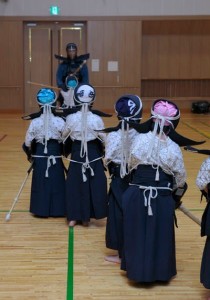 The Japanese university kendo club is the perfect environment for learning and improving kendo. Usually with at least one high grade teacher to direct training and correct faults, members rely on each other as training partners. Given that there is a maximum 4 year age and experience gap, groups are usually highly cohesive and supportive, with the more experienced seniors leading and encouraging their juniors. This encouragement may have occasionally in the past created some pressure for those at the front-end of the process, but most ex-university kendo players look back with appreciation at this stage of their kendo careers.
The Japanese university kendo club is the perfect environment for learning and improving kendo. Usually with at least one high grade teacher to direct training and correct faults, members rely on each other as training partners. Given that there is a maximum 4 year age and experience gap, groups are usually highly cohesive and supportive, with the more experienced seniors leading and encouraging their juniors. This encouragement may have occasionally in the past created some pressure for those at the front-end of the process, but most ex-university kendo players look back with appreciation at this stage of their kendo careers.
Those practising in general dojo face a much broader range of opponents. In smaller dojo, particularly in the West, if there are only a few of you, then you have no choice as to whom you practice with. Mawari-geiko may place you in front of a 25 year old 4th dan or a 60 year old rookie. In both cases the task is the same – to ensure that you each get the most value from each keiko.
There are some simple rules that guide us in most situations. If you are training with a much higher grade it is up to you to attack as well and as often as you can. If your opponent is your obvious junior you need to make and allow opportunities for him to attack. This all sounds fairly straightforward, but what do you do with partner of your own grade who is much older than you, or heaven forbid, a child who is much stronger than you.
The latter is not as unusual as it may sound. At Mumeishi we have had a number of junior and middle school champions in our kid’s classes who could knock spots off some of our adults. As a rule of thumb it is best to ensure that children train together or only with experienced motodachi, but at the occasional godogeiko, I have seen a few surprised seniors as these junior tornadoes attack from all directions. The key challenge when training with children, or much smaller adult opponents is to ensure that you work on your own seme and control the situation but avoid body contact or hitting too hard.
With older adults whose footwork might not be what it was, your objective could be to find good opportunities to attack against timing that is slightly different from that of younger kenshi.
Approached with the right mind-set, every keiko is a valuable experience, but if you are constantly training with the same few people then try to visit other dojo and practise with as many teachers as you can.









